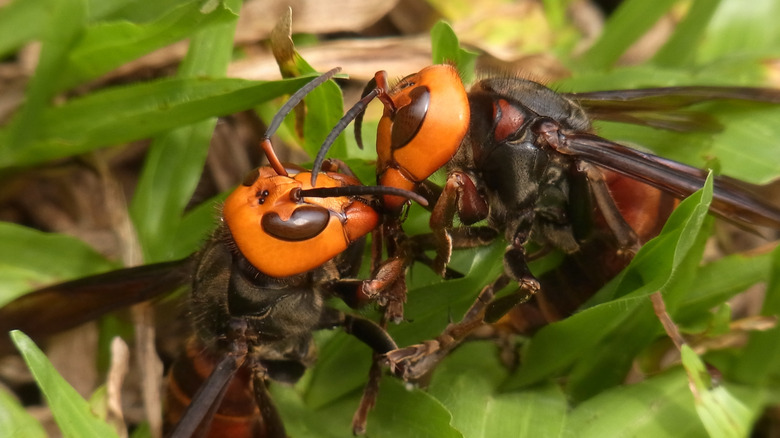Here's What Happened To The Murder Hornets In Washington State
Along with being the largest species of hornet on Earth, murder hornets (Vespa mandarinia) get their name because they attack and destroy honey bees and hives. Hornets have a beneficial role in the ecosystem, but these predators of honey bees are brutal killers. They decapitate the bees, demolish and take over entire hives in just hours, and return to their hives to feed the honey bee eggs, larvae, and pupae to their own young. That's why officials with the Washington State Department of Agriculture moved to get rid of the insects as soon as they were sighted in the state.
The WSDA first received reports of northern giant hornets — the official common name established by the Entomological Society of America — in December 2019 shortly after Canada found two nests in British Columbia. More reports were received in 2020 and 2021. While investigating the reports in Whatcom County, Washington, officials found the wasps by capturing some lone hornets and using radio trackers to follow them back to their nests. Then, they set traps with grape juice, strawberry jam, and other lures to attract the insects and eliminate their nests.
Protecting against the northern giant hornet
While there have been no confirmed northern giant hornet sightings since the end of 2021, the Washington Invasive Species Council encourages the public to help it and the WSDA keep an eye out for the murderous wasps. The reason is because their invasive behavior will have negative effects on the state's environment, public health, and economy. If the hornets were to become established and spread to other states, these effects could become widespread. Learning to identify these types of wasps is the first step toward doing that.
Native to Asia, northern giant hornets have orange or yellow heads with black eyes. It's a vast distinction from the almost solid dark brown to black thorax. The abdomen is also dark in color but has alternating rings of either orange or yellow that match the head. While the average worker is about 1.5 inches long, the queen can grow to 2 inches long with a wingspan of 3 inches.
The WSDA notes that northern giant hornets don't usually attack pets or people, but they might if they feel threatened. It's important not to antagonize them if they cross your path because their stingers are longer than those of honey bees and other wasps. Also, they can sting multiple times and have more potent venom. Rather than mess with the wasps, report the sighting to the agency or the Washington Invasive Species Council along with a photo and a description of the insect or hive location.

